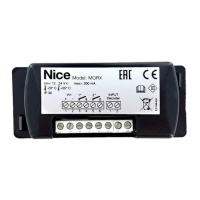37
GB
x4
x1
x3
x2
x3
= 1
= 3
= 2
total 132
Table “F10” Load the operations counter associated with a CARD Example
Each CARD is associated with a counter that subtracts 1 from an initial value every time
the CARD is used; when the counter reaches zero the CARD is deactivated.
The maximum value of the counter is 999, higher values mean unlimited operations.
At the outset, all the CARDS have unlimited operations.
1. Pass the MASTER in front of the reader four times (see note)
2. After 2 seconds 3 tones will be heard (hundreds enabled)
3. Pass the relative CARD in front of the READER a number of times equal to the hundreds required
(10 = unlimited)
4. After 2 seconds 2 tones will be heard (tens enabled)
5. Pass the relative CARD in front of the READER a number of times equal to the tens required
6. After 2 seconds, 1 tone will be heard (units enabled)
7. Pass the relative CARD in front of the READER a number of times equal to the units required
N.B.: At step 1, MASTER 1, MASTER 2 or the SOLE MASTER must be used depending on which group the CARD to reload belongs to.
(In the example, the counter has been reloaded to a value of 132).
Table “F9” Counts the memorised CARDS Example
This function checks the number of CARDS valid for an output
1. Pass the MASTER in front of the reader three times (see note)
Some sequences of tones will now be heard; these mean:
3 tones = 1 hundred (therefore one 3 tone sequence corresponds to 100 CARDS)
2 tones = 1 ten (therefore three 2 tone sequences correspond to 30 CARDS)
1 tone = 1 unit (therefore two 1 tone sequences correspond to 2 CARDS)
Zero is represented by 10 sequences of tones
N.B.: At step 1, MASTER 1, MASTER 2 or the SOLE MASTER must be used depending on which group the CARDS to count belong to.
The Sole Master is used to count all the cards, regardless of whether they are active only on output N°1, only on N°2 or on both.

